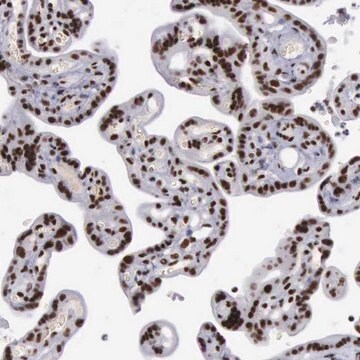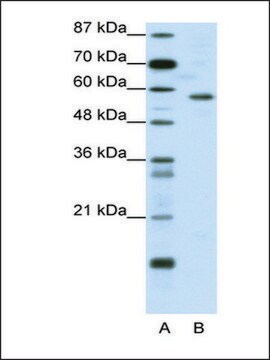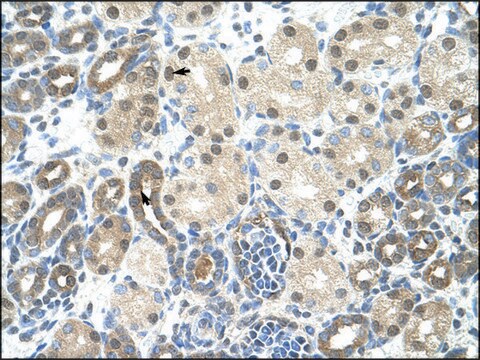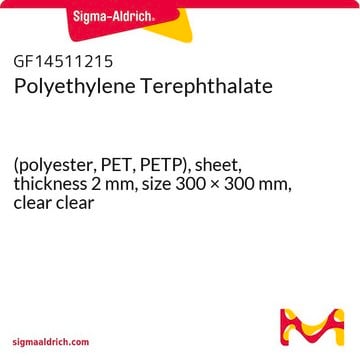General description
We are committed to bringing you greener alternative products, which adhere to one or more of The 12 Principles of Green Chemistry. This antibody is Preservative-free, produced without the harm or sacrifice of animals and exceptionally stable to allow for ambient shipping and storage if needed and thus aligns with "Waste Prevention", "Designing Safer Chemicals" and "Design for Energy Efficiency".
Click here for more information.
ZooMAb® antibodies represent an entirely new generation of recombinant monoclonal antibodies. Each ZooMAb® antibody is manufactured using our proprietary recombinant expression system, purified to homogeneity, and precisely dispensed to produce robust and highly reproducible lot-to-lot consistency. Only top-performing clones are released for use by researchers. Each antibody is validated for high specificity and affinity across multiple applications, including its most commonly used application. ZooMAb® antibodies are reliably available and ready to ship when you need them.
Specificity
Clone 1M12 is a ZooMAb® rabbit recombinant monoclonal antibody that specifically detects Transcriptional repressor protein YY1. It targets an epitope within 15 amino acids from the C-terminal half.
Immunogen
KLH-conjugated linear peptide corresponding to 15 amino acids from the C-terminal half of human Transcriptional repressor protein YY1.
Application
Quality Control Testing
Evaluated by Western Blotting in HeLa cell lysate.
Western Blotting Analysis: A 1:1,000 dilution of this antibody detected YY1/Ying-Yang 1 in HeLa cell lysate.
Tested Applications
Western Blotting Analysis: A 1:1,000 dilution from a representative lot detected His-ABP-tagged recombinant fragment of Human YY1/Ying-Yang 1 protein.
Enzyme Immunoassay (ELISA) Analysis: A serial of dilutions from a representative lot detected His-ABP-tagged recombinant fragment of Human YY1/Ying-Yang 1 protein.
Affinity Binding Assay: A representative lot of this antibody bound YY1/Ying-Yang 1 peptide with a KD of 1.1 x 10-7 in an affinity binding assay.
Note: Actual optimal working dilutions must be determined by end user as specimens, and experimental conditions may vary with the end user.
Target description
Transcriptional repressor protein YY1 (UniProt: P25490; also known as Delta transcription factor, INO80 complex subunit S, NF-E1, Yin and yang 1, YY-1) is encoded by the YY1 (also known as INO80S) gene (Gene ID: 7528) in human. YY-1 is a ubiquitously distributed transcription factor of the GLI-Kruppel class of zinc finger proteins. It exhibits positive and negative control on a large number of cellular and viral genes by binding to sites overlapping the transcription start site. It binds to the consensus sequence 5′-CCGCCATNTT-3′; however, some genes are reported to have a longer binding motif that allows enhanced binding. Its DNA binding domain is localized to amino acids 295-414. Its effect on transcription regulation is depends on the context in which it binds, and its diverse mechanisms of action include direct activation or repression, indirect activation or repression via cofactor recruitment, or activation or repression by disruption of binding sites or conformational DNA changes. YY-1 activity is regulated by transcription factors and cytoplasmic proteins that have been shown to abolish YY1-mediated activation or repression. It is reported to play an important role in development, differentiation, and DNA repair. It is also shown to act synergistically with the SMAD1 and SMAD4 in bone morphogenetic protein-mediated cardiac-specific gene expression. It binds to SMAD binding elements within the BMP response element of cardiac activating regions. In response to apoptosis signals, it is proteolytically cleaved by caspase-7. However, phosphorylation at serine 118 by casein kinase 2 prevents its cleavage by caspase-7. Mutations in YY1 gene have been linked to insulinoma with marked increase in insulin secretion. T372R mutation is neomorphic that results in constitutive activation of cAMP and calcium signaling pathways involved in insulin secretion. This ZooMAb® recombinant monoclonal antibody, generated by our propriety technology, offers significantly enhanced specificity, affinity, reproducibility, and stability over conventional monoclonals. (Ref.: Cromer, MK., et al. (2015). Proc. Natl. Acad. Sci. USA. 112(13); 4062-4067; Cai, Y., et al. (2007). Nat. Struct. Mol. Biol. 14(9); 872-874; Lee, KH., et al. (2004). Development. 131(19); 4709-4723).
Physical form
Purified recombinant rabbit monoclonal antibody IgG, lyophilized in PBS, 5% Trehalose, normal appearance a coarse or translucent resin. The PBS/trehalose components in the ZooMAb formulation can have the appearance of a semi-solid (bead like gel) after lyophilization. This is a normal phenomenon. Please follow the recommended reconstitution procedure in the data sheet to dissolve the semi-solid, bead-like, gel-appearing material. The resulting antibody solution is completely stable and functional as proven by full functional testing. Contains no biocide or preservatives, such as azide, or any animal by-products. Larger pack sizes provided as multiples of 25 µL.
Reconstitution
300 µg/mL after reconstitution at 25 µL per vial. Please refer to guidance on suggested starting dilutions and/or titers per application and sample type.
Storage and Stability
Recommend storage of lyophilized product at 2-8°C; Before reconstitution, micro-centrifuge vials briefly to spin down material to bottom of the vial; Reconstitute each vial by adding 25 µL of filtered lab grade water or PBS; Reconstituted antibodies can be stored at 2-8°C, or -20°C for long term storage. Avoid repeated freeze-thaws.
Other Notes
Concentration: Please refer to the Certificate of Analysis for the lot-specific concentration.
Legal Information
ZooMAb is a registered trademark of Merck KGaA, Darmstadt, Germany
Disclaimer
Unless otherwise stated in our catalog or other company documentation accompanying the product(s), our products are intended for research use only and are not to be used for any other purpose, which includes but is not limited to, unauthorized commercial uses, in vitro diagnostic uses, ex vivo or in vivo therapeutic uses or any type of consumption or application to humans or animals.

![4-Methyl-N-propyl-3-[[(2RS)-2-(propylamino)propanoyl]amino]thiophene-2-carboxamide hydrochloride certified reference material, TraceCERT®, Manufactured by: Sigma-Aldrich Production GmbH, Switzerland](/deepweb/assets/sigmaaldrich/product/structures/277/493/7651cc5d-47a5-4017-836e-5a3c52875481/640/7651cc5d-47a5-4017-836e-5a3c52875481.png)








